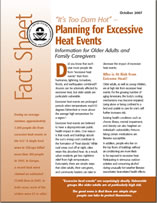Planning for Extreme Heat

Preventative Steps to Reduce your Risk for Illness during Excessive Heat Events
Many older adults are at a heightened risk for heat-related illness or death. With age, the body’s cooling mechanisms may become impaired and living alone or confined to a bed can further increase risk. This page describes the many simple preventative steps you can take to decrease the impact of excessive heat events.
Reducing your Risk during Excessive Heat Events
Excessive heat events: Excessive heat events are prolonged periods when temperatures reach 10 degrees Fahrenheit or more above the average high temperature for a region
Who is at risk from extreme heat: Older adults, young children as well as those with chronic illnesses are at high risk from excessive heat events. In addition, people who live on top floors without air conditioning, participate in strenuous outdoor activities and consume alcohol are more likely to be at risk.
What is heat stroke: Heat stroke is the most serious health effect of excessive heat events, when the body loses its ability to cool itself. If not treated immediately, heat stroke can cause severe and permanent damage to vital organs.
How to identify heat stroke: Victims' skin will appears hot, dry, and red. Other warning signs are confusion, hallucinations, and aggression.
How to protect against exposure to excessive heat:
- Air-conditioning, even for a few hours a day, can greatly reduce the risk of illness or death.
- Other prevention strategies are:
- Taking a cool shower or bath,
- Drinking plenty of fluids,
- Avoiding beverages containing caffeine, or alcohol,
- Wearing clothing that is lightweight, light-colored, and loose fighting.
- Ask your doctor if the medication you take increases your susceptibility to heat-related illness,
- Visit at-risk individuals twice a day
- Call 9-1-1 if medical attention is needed.
Resources:
Fact Sheets:
- It’s Too Darn Hot: Planning for Excessive Heat Events (4pp, 246K, About PDF)
Publication Number EPA-100-F-07-025 - Spanish (PDF) (4pp, 165K, About PDF)
Publication Number EPA-100-F-05-001 - Arabic | العربية (PDF) (2pp, 153MB , About PDF)
Publication Number 100-F-07-005 - Armenian (PDF) (4pp, 743K, About PDF)
Publication Number EPA-100-F-08-024 - Chinese (PDF) (4pp, 1.8 MB, About PDF)
Publication Number EPA-100-F-04-024 - French (PDF) (4pp, 459K, About PDF)
Publication Number EPA-100-F-07-019 - Haitian
Creole (PDF) (4pp, 251K, About PDF)
Publication Number EPA-100-F-05-035 - Italian (PDF) (4pp, 195K, About PDF)
Publication Number EPA-100-F-07-031 - Korean (PDF) (4pp, 847K, About PDF)
Publication Number EPA-100-F-05-037 - Polish | Polski (PDF) (4pp, 361K, About PDF)
Publication Number EPA-100-F-07-052 - Portuguese (PDF) (4pp, 195K, About PDF)
Publication Number EPA-100-F-05-054 - Russian (PDF) (4pp, 182K, About PDF)
Publication Number EPA-100-F-05-016 - Spanish (PDF) (4pp, 165K, About PDF)
Publication Number EPA-100-F-05-001 - Portuguese (PDF) (4 pp, 195K, About PDF)
Publication Number EPA-100-F-05-054 - Vietnamese | Tiếng Việt (PDF) (4pp, 724K, About PDF)
Publication Number EPA-100-F-05-048
Posters:
- Beat
the Heat - 8 Simple Steps for Older Adults (PDF) (1p, 310K, About PDF)
Publication Number: EPA-430-H-05004 - Spanish translation of: Beat the Heat Poster | Venza el calor: 8 pasos sencillos para los adultos de los años dorados (PDF) (1p, 330K, About PDF)
Publication Number: EPA 100-H-07-002
Extreme Heat: Effects on Children and Pregnant Women
For more detailed information, please see our series of easy-to-follow facts sheets and brochures.
![[logo] US EPA](https://webarchive.library.unt.edu/eot2008/20081017013614im_/http://www.epa.gov/epafiles/images/logo_epaseal.gif)
